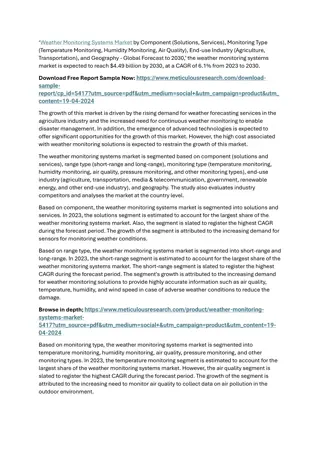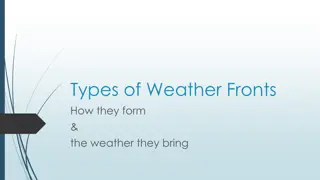Understanding Weather: Key Concepts and Factors Explained
Weather is the combination of various elements such as temperature, wind, humidity, and more. Wind is the movement of air, temperature is the measure of energy, and relative humidity indicates the amount of moisture in the air compared to its capacity. Dew point is the temperature at which air becomes saturated, leading to conditions like fog or precipitation. Explore how these factors influence our daily weather experiences and forecasts.
Download Presentation

Please find below an Image/Link to download the presentation.
The content on the website is provided AS IS for your information and personal use only. It may not be sold, licensed, or shared on other websites without obtaining consent from the author. Download presentation by click this link. If you encounter any issues during the download, it is possible that the publisher has removed the file from their server.
E N D
Presentation Transcript
Do Now 1. What is weather? 2. What is wind? 3. What is temperature? Short term condition of atmosphere? Moving Air Indirect measure of energy Put Homework (Land & Sea Breeze) on File Cabinet
Dew Point and Relative Humidity 3 March 2022
The amount of water air can hold depends on temperature As temperature increases air can hold more water Too cold to snow Absolute humidity ( the amount of water physically present) is a constant To change the absolute humidity water must be added or subtracted
Relative humidity also measures water vapor but RELATIVE to the temperature of the air. It is expressed as the amount of water vapor in the air as a percentage of the total amount that could be held at its current temperature. Relative humidity is the amount of moisture in the air compared to how much it can hold Warm air can hold far more moisture than cold air meaning that the relative humidity of cold air would be far higher than warm air if their absolute humidity levels were equal. Relative humidity is cited in weather forecasts as it affects how we feel temperature
Relative Humidity Relative Humidity is the amount of moisture in the air compared to what the air can hold It is given as a percentage It will vary as the temperature changes
Dew point Temperature is the temperature at which air is saturated Saturated air is air that holds as much water as it can (The air is full) The dew point is the temperature the air needs to be cooled to (at constant pressure) in order to achieve a relative humidity (RH) of 100%. At this point the air cannot hold anymore water in the gas form. If the air were to be cooled even more, water vapor would have to come out of the atmosphere in the liquid form, usually as fog or precipitation.
Dew Point Dewpoint is the temperature at which the air is saturated Dew point can only be changed by changing the amount of moisture in the air The closer the air temperature and the Dewpoint are together the more likely precipitation is likely to occur Dewpoint temperature is measured in degrees Celsius
Humidity 48% Wind Speed NW 13 G 24 mph 30.00 in (1015.8 mb) 39 F 4 C Barometer Dewpoint 21 F (-6 C) Visibility 10.00 mi Wind Chill 31 F (-1 C) Last update3 Mar 8:51 am EST
Relative Humidity and Dewpoint are found with a Sling Psychrometer
In the example (above) the dry bulb (air temperature) is 22 C and the wet bulb is 16 C. Using the chart below find the Relative Humidity.
Humidity 48% Wind SpeedNW 13 G 24 mph 39 F 4 C Barometer30.00 in (1015.8 mb) Dewpoint 21 F (-7 C) Visibility 10.00 mi Wind Chill 31 F (-1 C) Last update3 Mar 8:51 am EST
To use the chart: Subtract the ______bulb temperature from the ______bulb to find the ___________________ (wet bulb depression) On the dewpoint temperature chart follow the horizontal row across from the _________ temperature until it meets the vertical column coming down from the _____________ At the intersection read the ______________ temperature
Find the dewpoint given the dry and wet bulb readings 20oC 17oC 15oC 5oC 3oC 2.5oC
Find the dewpoint given the dry and wet bulb readings -4 -1 3 3/2 1.5 2.5oC
62 and 64 63%
If there is no number in the Relative Humidity chart it is zero. If there is no number in the Dewpoint Chart the answer is None If you are finished with the worksheet on the bottom of page two, under the cartoon, write the dry bulb temperature and the wet bulb temperature for the room and find the dewpoint for the room























